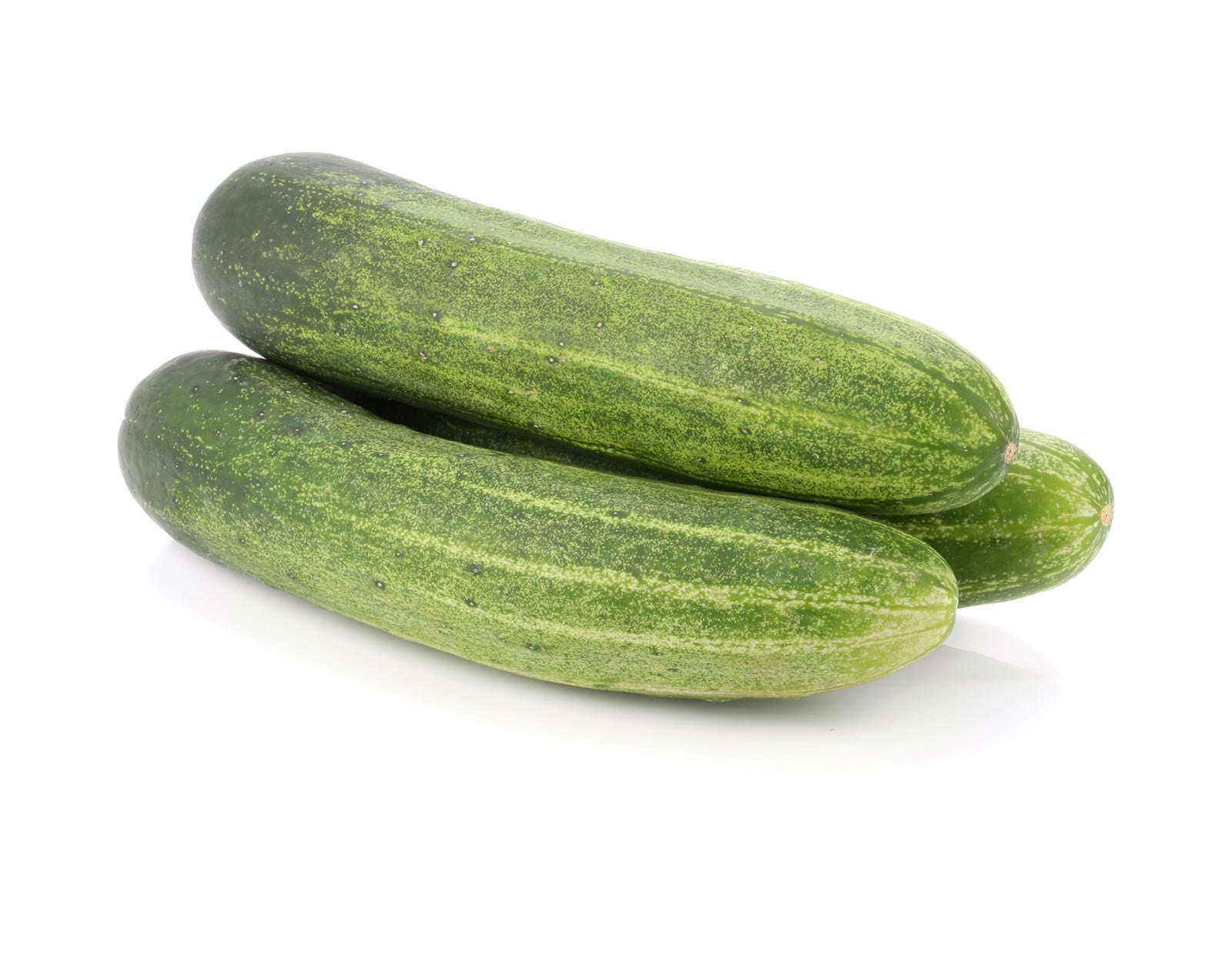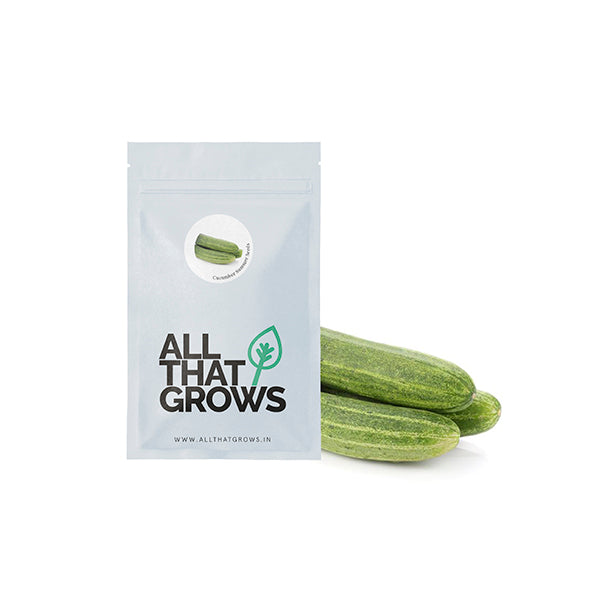



Cucumber Summer Seeds
Seed Type : Non-Hybrid, Open Pollinated and Non-GMO
Sowing time : February-March
Fruit Length : 7-8 inches, straight
Fruit Weight : 200 - 250 gms
Fruit colour : Light green
First Picking : After 50-55 days from sowing
Specification : Sweet in taste, high yield
- SOWING
TIMEFeb - Mar
- Sowing
DistancePlant to plant - 1'
Line to line - 4' - Fruit
Weight200 - 250 gms
- Fruit
Shapelong and
cylindrical - Days to
maturity50-55 days
- Details
- How to sow
- Reviews
Belonging to the Cucurbitaceae family of plants, same as melons and squash, cucumbers originated in parts of Middle East and Western Asia, but particularly in India. The elongated, water-rich, and light-on-the-palette vegetable is an effective way of getting rid of internal heat, flushing out toxins, while still sufficiently hydrating to prevent dehydration. Also, low on calories, cucumbers are rich in Vitamin A, C, K, folate, magnesium, potassium, calcium, iron, copper, zinc, and many other nutrients and minerals. Being a potent source of antioxidants, cucumbers impart enough nourishment for the skin to look healthy and can also reduce puffiness around eyes, and treat swelling and sunburns too. Also with anti-inflammation and anti-cancer properties, there is no possible excuse one can come up with, to not eat them. In fact, people looking to maintain or reduce weight should have these on a daily basis with their meals.
Cucumbers are popularly consumed raw in salads, sandwiches, smoothies, and cold soups. Just wash, peel, and you are good to go. But if you are bored with the regular way of eating cucumbers, then try pickling them.
Planting instructions
Cucumbers are seeded or transplanted outdoors not earlier than 2 weeks after the last frost date.
For an early crop, sow cucumber seeds indoors, approximately 3 weeks before you transplant them.
Improve clay soil by adding organic matter. Make certain that soil is moist and well-drained, not waterlogged.
Mix in compost and/or aged manure before planting to a depth of 2 inches and work into the soil 6 to 8 inches deep. Sow seeds in rows, 1 inch deep and 6 to 10 inches asunder.
If you are transplanting seedlings, plant them 12 inches apart. A trellis might be a safe idea if you want the vine to climb, or if you have limited space.
Growing Requirements
watering
When seedlings emerge, begin to water frequently, and increase to a gallon per week after fruit forms.
pests
Pests that can attack this crop: Cucumber Beetles, Whiteflies, Bacterial Wilt, Anthracnose, Mosaic Viruses. The above mentioned pests might affect the plant leaving a honeydew substance behind that turns leaves pale yellow or might result in larvaes that leave holes in roots and stems below soil line. Adult pests chew leaves and may spread wilt and mosaic diseases.
soil
Ideally, soil should be neutral or slightly alkaline with a pH of 7.0. Light, sandy soils are preferred as they get warm quickly.
spot
Select a site full of sunlight.
temperature
The soil must be at least 65ºF for germination with a bottom heat of about 70ºF (21ºC).
how to harvest
Harvest dills at 4 to 6 inches long and pickles at 2 inches long for pickles. The large burpless cucumbers can be up to 10 inches long and some types still bigger.
Cucumbers are best picked before their seeds become hard and are eaten when immature. Do not let them get brown.
A cucumber is of the highest quality when it is uniformly green, steady and snappy.
Any cucumbers left on the vine for too long will get tough skins and lower plant productivity.
At the peak of harvest season, pick cucumbers every couple of days.
Keep them picked. If you don’t, as plants mature, they will cease growing.
Wrap tightly in plastic wrap to keep moisture away.
They will last for a week to 10 days when stored properly in the refrigerator.

The productiveness of any seed we sell is subject to your local climatic conditions*, the sowing method you adopt, and your commitment to the planting process. We give no warranty, expressed or implied, and are in no way responsible for the produce.
Please note that all our seasonal recommendations/ sowing information is as per the local climatic conditions. *For more information on the optimum conditions required for growing seeds in your region, please contact us at, hello@allthatgrows.in or Whatsapp us at, +91 8544865077
Questions & Answers
Ask a Question-
Hi, do all flowers turn into fruits or does the plant produce male flowers as well?
Cucumber also has some male flowers.
-
Is it feasible to grow cucumber in Bangalore based on climatic conditions?
The soil must be at least 18°C for germination with a bottom heat of about 21°C.
-
Will the seeds germinate in the month of September? The weather is rainy and quite humid in North India.
Coriander seeds will germinate in September the only factor is that if the seeds are sown and start germination and then it rains ..then the sprout can die due to wetter logging ...in a covered area they will grow well!




Cucumber Summer Seeds
Seed Type : Non-Hybrid, Open Pollinated and Non-GMO
Sowing time : February-March
Fruit Length : 7-8 inches, straight
Fruit Weight : 200 - 250 gms
Fruit colour : Light green
First Picking : After 50-55 days from sowing
Specification : Sweet in taste, high yield
Belonging to the Cucurbitaceae family of plants, same as melons and squash, cucumbers originated in parts of Middle East and Western Asia, but particularly in India. The elongated, water-rich, and light-on-the-palette vegetable is an effective way of getting rid of internal heat, flushing out toxins, while still sufficiently hydrating to prevent dehydration. Also, low on calories, cucumbers are rich in Vitamin A, C, K, folate, magnesium, potassium, calcium, iron, copper, zinc, and many other nutrients and minerals. Being a potent source of antioxidants, cucumbers impart enough nourishment for the skin to look healthy and can also reduce puffiness around eyes, and treat swelling and sunburns too. Also with anti-inflammation and anti-cancer properties, there is no possible excuse one can come up with, to not eat them. In fact, people looking to maintain or reduce weight should have these on a daily basis with their meals.
Cucumbers are popularly consumed raw in salads, sandwiches, smoothies, and cold soups. Just wash, peel, and you are good to go. But if you are bored with the regular way of eating cucumbers, then try pickling them.
Seed Type : Non-Hybrid, Open Pollinated and Non-GMO
Sowing time : February-March
Fruit Length : 7-8 inches, straight
Fruit Weight : 200 - 250 gms
Fruit colour : Light green
First Picking : After 50-55 days from sowing
Specification : Sweet in taste, high yield
- SOWING
TIMEFeb - Mar
- Sowing
DistancePlant to plant - 1'
Line to line - 4' - Fruit
Weight200 - 250 gms
- Fruit
Shapelong and
cylindrical - Days to
maturity50-55 days
Planting instructions
Cucumbers are seeded or transplanted outdoors not earlier than 2 weeks after the last frost date.
For an early crop, sow cucumber seeds indoors, approximately 3 weeks before you transplant them.
Improve clay soil by adding organic matter. Make certain that soil is moist and well-drained, not waterlogged.
Mix in compost and/or aged manure before planting to a depth of 2 inches and work into the soil 6 to 8 inches deep. Sow seeds in rows, 1 inch deep and 6 to 10 inches asunder.
If you are transplanting seedlings, plant them 12 inches apart. A trellis might be a safe idea if you want the vine to climb, or if you have limited space.
Growing Requirements
watering
When seedlings emerge, begin to water frequently, and increase to a gallon per week after fruit forms.
pests
Pests that can attack this crop: Cucumber Beetles, Whiteflies, Bacterial Wilt, Anthracnose, Mosaic Viruses. The above mentioned pests might affect the plant leaving a honeydew substance behind that turns leaves pale yellow or might result in larvaes that leave holes in roots and stems below soil line. Adult pests chew leaves and may spread wilt and mosaic diseases.
soil
Ideally, soil should be neutral or slightly alkaline with a pH of 7.0. Light, sandy soils are preferred as they get warm quickly.
spot
Select a site full of sunlight.
temperature
The soil must be at least 65ºF for germination with a bottom heat of about 70ºF (21ºC).
how to harvest
Harvest dills at 4 to 6 inches long and pickles at 2 inches long for pickles. The large burpless cucumbers can be up to 10 inches long and some types still bigger.
Cucumbers are best picked before their seeds become hard and are eaten when immature. Do not let them get brown.
A cucumber is of the highest quality when it is uniformly green, steady and snappy.
Any cucumbers left on the vine for too long will get tough skins and lower plant productivity.
At the peak of harvest season, pick cucumbers every couple of days.
Keep them picked. If you don’t, as plants mature, they will cease growing.
Wrap tightly in plastic wrap to keep moisture away.
They will last for a week to 10 days when stored properly in the refrigerator.



 Sign In
Sign In








